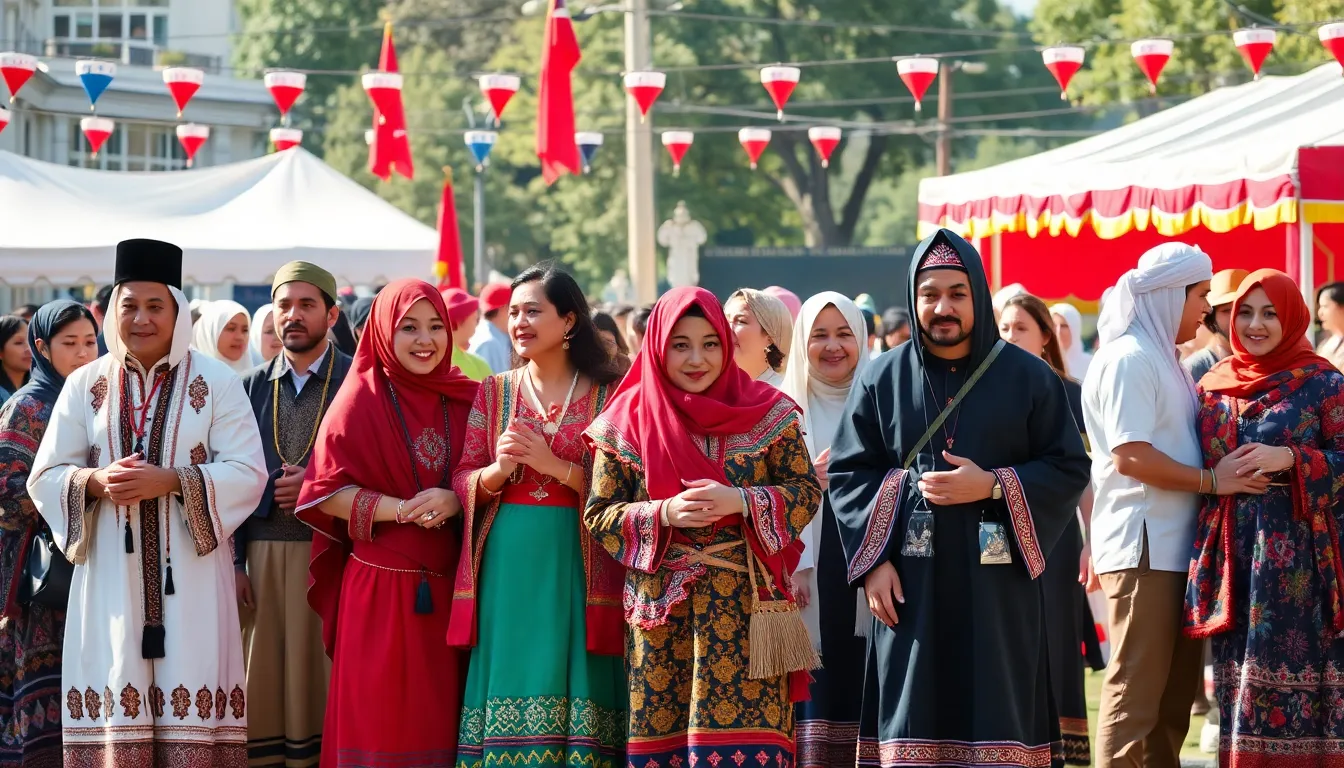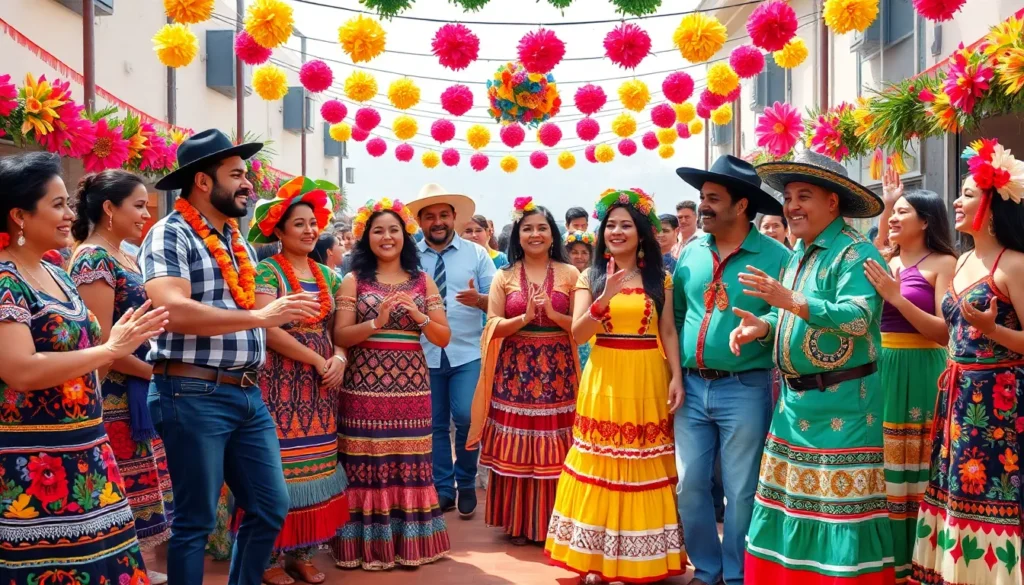Table of Contents
ToggleCultural groups are like the colorful threads in the fabric of society, each adding its unique pattern and story. From the vibrant festivals of the Latinx community to the rich traditions of Indigenous peoples, these groups shape our world in ways that are both profound and delightful. Understanding cultural groups isn’t just about appreciating differences; it’s about celebrating the quirks that make life interesting.
Imagine a world where everyone spoke the same language and danced to the same beat—yawn, right? Instead, let’s dive into the fascinating examples of cultural groups that not only enrich our lives but also keep things exciting. Buckle up for a journey through diverse traditions, languages, and customs that’ll have you nodding in appreciation and maybe even tapping your feet.
Understanding Cultural Groups
Cultural groups encompass communities bonded by shared characteristics, fostering unique identities. These groups illustrate the diversity of human experiences and expressions.
Definition of Cultural Groups
Cultural groups refer to communities that share common customs, beliefs, languages, and practices. These shared elements can include art, food, social behaviors, and traditions. Participants within cultural groups often connect through similar historical backgrounds or geographical locations. Understanding these definitions aids in recognizing the various influences that shape identities. Cultural groups encompass a broad spectrum, such as ethnic minorities, religious communities, and regional populations, each contributing distinct perspectives to society.
Importance of Cultural Diversity
Cultural diversity enriches societies by promoting creativity and innovation. Unique customs and traditions inspire new ideas through different viewpoints. Communities thriving on diverse cultures experience enhanced problem-solving abilities. Increased respect for varying traditions fosters social harmony and reduces tensions. Economically, cultural diversity can attract tourism and stimulate local businesses through unique offerings. Highlights of various cultures can be seen in festivals, cuisines, and arts, showcasing the vibrancy of human expression. Recognizing and celebrating cultural diversity allows for stronger, more resilient societies that value inclusivity.
Examples of Cultural Groups

Cultural groups represent the rich tapestry of human existence. Numerous examples provide insight into their significance.
Ethnic Groups
Ethnic groups share common ancestry, traditions, and cultural heritage. For instance, the Hispanic community encompasses diverse nationalities, including Mexicans, Puerto Ricans, and Cubans. Another example is the Ashkenazi Jews, noted for their distinct cultural practices and traditions originating in Central and Eastern Europe. The Maasai, a semi-nomadic tribe in East Africa, showcase rich traditions centered on livestock herding and distinctive clothing. Each ethnic group contributes unique perspectives to society, thereby enhancing cultural diversity and fostering understanding.
Religious Groups
Religious groups form around shared beliefs and spiritual practices. Christianity, encompassing denominations like Catholicism and Protestantism, boasts over 2 billion followers worldwide. Islam, with 1.9 billion adherents, includes various sects such as Sunni and Shia. Buddhism, rooted in the teachings of Siddhartha Gautama, emphasizes mindfulness and compassion. Each of these groups practices unique rituals that promote community and identity, proving vital in shaping societal values and norms.
Linguistic Groups
Linguistic groups unite individuals through language, often linking them to specific cultural identities. The Romance language group includes Spanish, Portuguese, and French speakers, showcasing shared linguistic roots from Latin. The Sino-Tibetan language family encompasses languages like Mandarin and Cantonese, reflecting rich cultural traditions in East Asia. Afro-Asiatic languages, such as Arabic and Amharic, connect millions and highlight diverse cultural narratives. Ultimately, understanding linguistic groups underscores the intricate connections between language, culture, and identity.
Global Cultural Groups
Cultural groups shape identities across the globe. Each group contributes distinct traditions and practices, enriching the collective human experience.
African Cultural Groups
African cultural groups display incredible diversity across the continent. Countries such as Nigeria host over 250 ethnic groups, each with unique languages and customs. The Zulu people in South Africa celebrate their heritage through traditional dances and vibrant clothing. Additionally, the Maasai are known for their pastoral lifestyle and colorful beadwork, symbolizing community and identity. Celebrations like the Gerewol Festival among the Wodaabe reflect deep-rooted beliefs and community ties. Understanding these groups brings awareness to Africa’s rich cultural mosaic.
Asian Cultural Groups
Asia encompasses a myriad of cultural groups, each with distinct traditions and languages. The Han Chinese, for example, make up over 90 percent of China’s population, contributing significantly to art, cuisine, and philosophy. The Indian subcontinent features diverse groups like Punjabis, Tamils, and Bengalis, each with unique festivals, such as Diwali and Pongal. The Japanese embrace traditions like tea ceremonies, illustrating their appreciation for aesthetics and mindfulness. Exploring these cultural groups highlights Asia’s complex tapestry, revealing interconnections and shared histories.
European Cultural Groups
European cultural groups exhibit a rich tapestry of languages and traditions. The Celtic communities of Ireland and Scotland celebrate their heritage with music, dance, and festivals like Samhain. Meanwhile, the Italian culture showcases regional diversity with distinct culinary traditions and dialects across the country. Countries such as Greece emphasize ancient customs, including folk dances and local festivals that preserve their history. By recognizing these groups, one can appreciate Europe’s profound contributions to art, philosophy, and literature that continue to influence the world today.
Impact of Cultural Groups on Society
Cultural groups significantly shape society in various ways, enriching everyday life and contributing to global progress. These communities foster creativity, innovation, and social cohesion through their unique traditions and customs.
Contributions to Arts and Sciences
Cultural groups contribute to the arts and sciences by introducing diverse perspectives and ideas. African musicians, for instance, influence global music with traditional rhythms and instruments. Indigenous knowledge systems provide unique insights into ecology, which inform modern scientific practices. Their artistic expressions, such as African masks and Latinx murals, highlight cultural narratives that broaden the understanding of human experiences. Numerous cultural festivals showcase rich artistic traditions, celebrating the heritage and creativity within communities. By integrating different cultural elements, societies inspire innovation and enhance creativity in various fields.
Influence on Global Politics
Cultural groups play an essential role in shaping global politics by fostering dialogue and understanding. Advocacy from marginalized cultures often leads to policies that promote social justice and equality. The voices of ethnic minorities, such as Indigenous peoples, resonate in discussions about land rights and environmental protection. Political movements inspired by cultural identities frequently challenge hegemonic narratives and bring new perspectives to the political landscape. Organizations representing cultural groups actively engage in diplomacy, facilitating cooperation among nations. As societies become increasingly interconnected, the influence of diverse cultural voices in politics becomes more pivotal in addressing complex global issues.
Embracing cultural diversity not only enriches individual lives but also strengthens communities. Each cultural group brings unique traditions and perspectives that enhance creativity and foster innovation. By recognizing and celebrating these differences, societies can cultivate inclusivity and resilience.
The vibrant tapestry of human experience is woven from the threads of various cultures, each contributing to a broader understanding of humanity. As individuals explore and appreciate these cultural groups, they participate in a journey that promotes social harmony and global connectivity. Ultimately, valuing cultural diversity leads to a more enriched and harmonious world for everyone.







